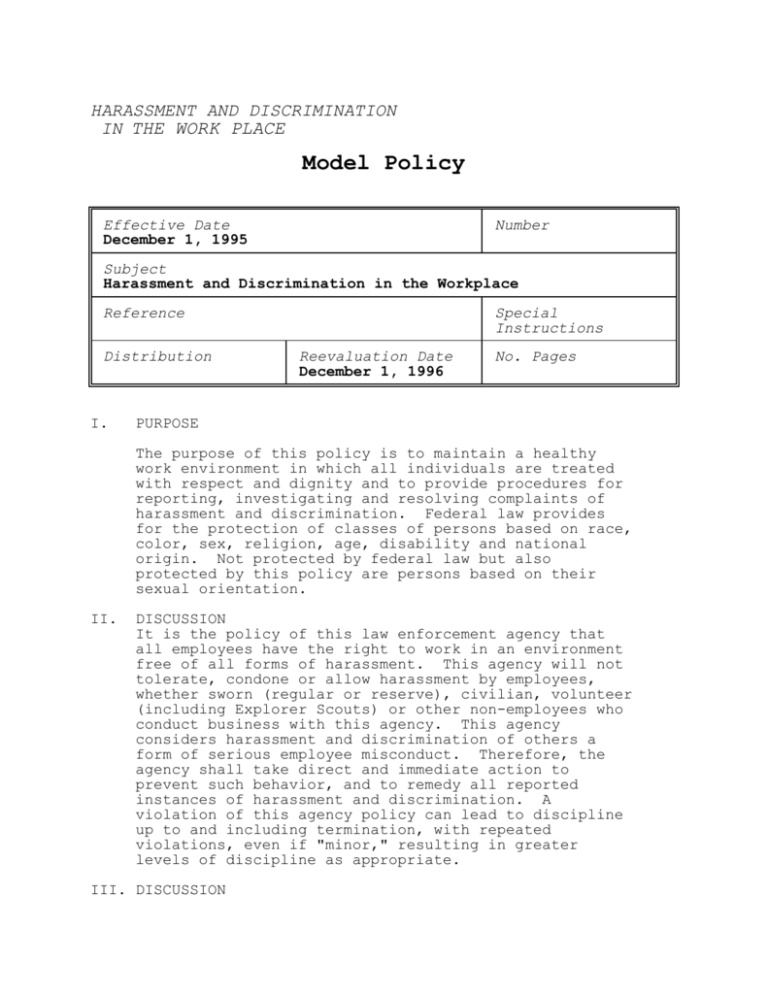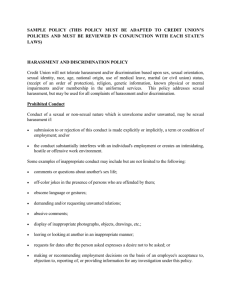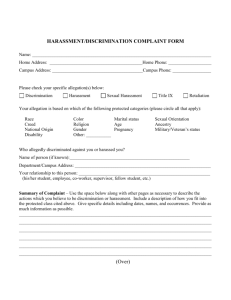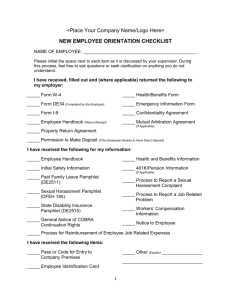
HARASSMENT AND DISCRIMINATION
IN THE WORK PLACE
Model Policy
Effective Date
December 1, 1995
Number
Subject
Harassment and Discrimination in the Workplace
Reference
Distribution
I.
Special
Instructions
Reevaluation Date
December 1, 1996
No. Pages
PURPOSE
The purpose of this policy is to maintain a healthy
work environment in which all individuals are treated
with respect and dignity and to provide procedures for
reporting, investigating and resolving complaints of
harassment and discrimination. Federal law provides
for the protection of classes of persons based on race,
color, sex, religion, age, disability and national
origin. Not protected by federal law but also
protected by this policy are persons based on their
sexual orientation.
II.
DISCUSSION
It is the policy of this law enforcement agency that
all employees have the right to work in an environment
free of all forms of harassment. This agency will not
tolerate, condone or allow harassment by employees,
whether sworn (regular or reserve), civilian, volunteer
(including Explorer Scouts) or other non-employees who
conduct business with this agency. This agency
considers harassment and discrimination of others a
form of serious employee misconduct. Therefore, the
agency shall take direct and immediate action to
prevent such behavior, and to remedy all reported
instances of harassment and discrimination. A
violation of this agency policy can lead to discipline
up to and including termination, with repeated
violations, even if "minor," resulting in greater
levels of discipline as appropriate.
III. DISCUSSION
A.
B.
Prohibited Activity
1.
No employee shall either explicitly or
implicitly
ridicule, mock, deride or
belittle any person.
2.
Employees shall not make offensive or
derogatory
comments to any person, either
directly or indirectly, based on race,
color, sex, religion, age, disability, sexual
orientation or national origin. Such
harassment is a prohibited form of
discrimination under state and federal
employment law and/or is also considered
misconduct subject to disciplinary action by
this agency.
3.
Sexual harassment is defined as unwelcome
sexual
advances, requests for sexual
favors, and other verbal or physical conduct
of a sexual nature when:
a.
Submission to such conduct is made
either explicitly or
implicitly a term or condition of
employment; or
b.
Submission to or rejection of such
conduct by an employee is used
as the basis for employment
decisions affecting the employee;
or
c.
Such conduct has the purpose or
effect of unreasonably interfering
with an employee's work performance
or creating an intimidating,
hostile or offensive working
environment.
4.
Individuals covered under the policy include
agency members defined as employees and
applicants for employment with the agency,
whether sworn, regular, reserve or civilian,
and all volunteers including but not limited
to Explorer Scouts.
Employee Responsibilities
1.
Each supervisor shall be responsible for
preventing acts of harassment. This
responsibility includes:
a.
Monitoring the unit work
environment on
a daily basis
for signs that harassment may be
occurring;
b.
Counseling all employees on the
types of behavior prohibited, and
the agency procedures for reporting
and resolving complaints of
harassment;
c.
Stopping any observed acts that may
C.
be
considered harassment, and
taking appropriate steps to
intervene, whether or not the
involved employees are within
his/her line of supervision; and
d.
Taking immediate action to prevent
retaliation towards
e.
the complaining party and to eliminate
the hostile work environment where there
has been a complaint of harassment,
pending investigation.If a situation
requires separation of the parties, care
should be taken to avoid actions that
appear to punish the complainant.
Transfer or reassignment of any of the
parties involved should be voluntary if
possible and, if non-voluntary, should
be temporary pending the outcome of the
investigation.
e.
Failure to carry out these
responsibilities will be
considered in any evaluation or
promotional decision and may be
grounds for discipline.
2.
Each supervisor has the responsibility to
assist
any employee of this agency who
comes to that supervisor with a complaint of
harassment in documenting and filing a
complaint with the internal investigations
authority or other investigatory authority as
designated by this agency.
3.
Each employee of this agency is responsible
for assisting in the prevention of
harassment through the following acts:
a.
Refraining from participation in,
or
encouragement of, actions that
could be perceived as harassment;
b.
Reporting acts of harassment to a
supervisor; and
c.
Encouraging any employee who
confides that he or she is being
harassed or discriminated against
to report these acts to a
supervisor.
4.
Failure of any employee to carry out the
above
responsibilities will be considered
in any performance evaluation or promotional
decision and may be grounds for discipline.
Complaint Procedures
1.
Any employee encountering harassment is
encouraged to inform the person that his or
her actions are unwelcome and offensive. The
employee is encouraged to document all
incidents of harassment in order to provide
2.
3.
the fullest basis for investigation.
Any employee who believes that he or she is
being
harassed shall report the
incident(s) as soon as possible so that steps
may be taken to protect the employee from
further harassment, and so that appropriate
investigative and disciplinary measures may
be initiated. Where doing so is not
practical, the employee may instead file a
complaint with another supervisor, with the
appropriate internal investigations authority
or the chief executive officer of the agency.
a.
The supervisor or other person to
whom a
complaint is given shall
meet with the employee and document
the incident(s) complained of, the
person(s) performing or
participating in the harassment,
any witnesses to the incident(s)
and the date(s) on which it
occurred.
b.
The agency employee taking the
complaint
shall promptly
submit a confidential memorandum
documenting the complaint to the
appropriate investigative
authority.
The internal investigation authority shall be
responsible for investigating any
complaint alleging harassment or
discrimination.
a.
The internal investigative
authority
shall immediately
notify the chief executive officer
and the prosecutor's office if the
complaint contains evidence of
criminal activity, such as battery,
rape or attempted rape.
b.
The investigator shall include a
determination as to whether
other employees are being harassed
by the person, and whether other
agency members participated in or
encouraged the harassment.
c.
The internal investigative
authority
shall inform the
parties involved of the outcome of
the investigation.
d.
A file of harassment and
discrimination
complaints
shall be maintained in a secure
location. The chief executive
officer shall be provided with an
annual summary of these complaints.
4.
D.
There shall be no retaliation against any
employee for filing a harassment or
discrimination complaint, or for assisting,
testifying or participating in the
investigation of such a complaint.
5.
The complaining party's confidentiality will
be
maintained throughout the investigatory
process to the extent practical and
appropriate under the circumstances.
6.
Complainants or employees accused of
harassment
may file a grievance/appeal in
accordance with agency procedures when they
disagree with the investigation or
disposition of a harassment claim.
7.
This policy does not preclude any employee
from
filing a complaint or grievance
with an appropriate outside agency.
Retaliation
1.
Retaliation against any employee for filing a
harassment or discrimination complaint,
or for assisting, testifying or participating
in the investigation of such a complaint, is
illegal and is prohibited by this agency and
by federal statutes.
2.
Retaliation is a form of employee misconduct.
Any evidence of retaliation shall be
considered a separate violation of this
policy and shall be handled by the same
complaint procedures established for
harassment and discrimination complaints.
3.
Monitoring to ensure that retaliation does
not occur is the responsibility of the chief
executive officer, supervisors and the
appropriate internal investigative authority.
This project was supported by Grant No. 87-SN-CX-KO77 awarded by
the Bureau of Justice Assistance, Office of Justice Programs,
U.S. Department of Justice. The Assistant Attorney General,
Office of Justice Programs, coordinates the activities of the
following program offices and bureaus: the Bureau of Justice
Assistance, the Bureau of Justice Statistics, National Institute
of Justice, Office of Juvenile Justice and Delinquency
Prevention, and the Office of Victims of Crime. Points of view
or opinions in this document are those of the author and do not
represent the official position or policies of the United States
Department of Justice.
Every effort has been made by the IACP National Law Enforcement
Policy Center staff and advisory board to ensure that this model
policy incorporates the most current information and contemporary
professional judgment on this issue. However, law enforcement
administrators should be cautioned that no "model" policy can
meet all the needs of any given law enforcement agency. Each law
enforcement agency operates in a unique environment of federal
court rulings, state laws, local ordinances, regulations,
judicial and administrative decisions and collective bargaining
agreements that must be considered. In addition, the formulation
of specific agency policies must take into account local
political and community perspectives and customs, prerogatives
and demands; often divergent law enforcement strategies and
philosophies; and the impact of varied agency resource
capabilities among other factors.









